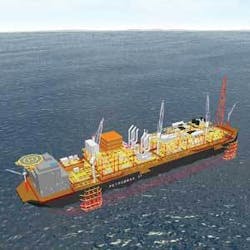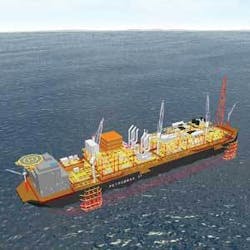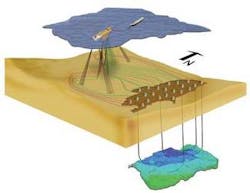Petrobras’ deepwater FPSO for processing heavy crude
A boost for sustainable oil self-sufficiency
Dayse Abrantes, Special Correspondent
Brazil’s current oil output is nearly 1.75 MMb/d, the bulk of which is heavy crude. As most Brazilian refineries, built during the 1970s, were mainly set up to process light oil, this has forced the country to export heavy oil and import light oil.
Despite the fact that Brazil will reach oil self-sufficiency this year, with output of some 1.9 MMb/d, the country will still continue to import light oil for a while.
Paulo Roberto Costa, downstream director of state-owned Petroleo Brasileiro SA (Petrobras) says that “in strategic terms, this does not diminish the importance of the country’s oil self-sufficiency. Imports of light oil have been dropping every year, while oil exports are expanding.”
According to Costa, in 2006 Petrobras expects to export 570,000 b/d of crude and oil products, which will result in a $3-billion trade surplus, after deducting expenditures with imports. This will be the first oil surplus in Brazil’s history. Last year the country had a deficit of $190 million.
The development of an innovative concept for an FPSO for heavy crude oil processing in very deep waters is one of the technical solutions presented by Petrobras to sustain the country’s oil self-sufficiency.
In an exclusive interview forOffshore magazine, Marcos I. Assayag, basic engineering general manager for upstream and downstream at Petrobras’ R&D center Cenpes, discussed the current status and future plans for FPSO development. Assayag said that in January of this year, Cenpes finished the front-end engineering and design (FEED) of the FPSO P-57, and that the FPSO will start operations in 2009 on Phase 2 of the Jubarte field development.
null
Jubarte development
The Jubarte field is located at water depths between 1,000 and 1,500 m, north of the Campos basin and 77 km off the coast of Espírito Santo state. Discovered in January 2001, the field contains 17° API oil. The dead oil viscosity at 20°C is about 3,300 cP (centipoise), making it the most viscous oil at surface conditions ever produced in Brazil through a wet completion system.
The field’s reservoir was estimated at 700,000 bbl and was discovered in the BC-60 block, where reserves reached 2 Bbbl. Petrobras considers the BC-60 block a laboratory for knowledge acquisition in the development of heavy offshore oil reservoirs in deep waters, says Assayag.
Challenges with heavy oil
Heavy oils are difficult to produce because their high viscosity hinders both the flow in the porous rock media and the displacement efficiency of injected fluids to increase production. Water-flooding seems to be the only feasible way to produce heavy oil in deepwater using existing technology. The use of production units with high processing capacity, handling a comprehensive amount of liquids, has been shown to be one of the most attractive solutions for this scenario, says Roberto de Oliveira Goulart, Jubarte field basic design coordinator at Cenpes.
It is difficult to prove the economic viability of producing heavy oil in deepwater. Heavy oil separation and treatment involve the separation of oil, gas, water, and solids. Although this process is fairly straightforward when dealing with conventional crude, it is much more difficult when dealing with heavy oil, say both Goulart and Assayag.
Heavy oil processing poses significant problems to engineers, not only because of the characteristics of the reservoir fluids being processed, but also because of the limited space and weight available on the offshore production unit.
Heavy crude dehydration and desalting present further problems, including high viscosity, the presence of suspended solids and semi-soluble components, and the limited differential density for driving the sedimentation-based separation. To achieve practical sedimentation rates, the viscosity must be reduced by operating at elevated temperatures, which, in turn, results in increasing the solubility of the water in the oil.
Oil-water separation, including the oil treatment to meet refinery requirements, is perhaps the most critical stage of offshore heavy oil development. The use of existing technology results in very high separation temperatures.
Development in stages
Due to the challenges presented by heavy crude, the field is being developed through a single pilot program and two full-scale projects following two extended well tests (EWT) Petrobras performed.
Goulart says EWT in offshore fields comprise the best strategy to reduce the uncertainties and mitigate the risks before starting the major investments associated with a final production system.
The field architecture approach for development of the Jubarte field comprises the following phases:
- EWT and pilot, with the dynamically positioned FPSOSeillean
- Early production system (EPS) at Phase I of the development, FPSOP-34
- Definitive production system, Phase II of the development, FPSOP-57.
Petrobras has a long tradition of performing EWT or operating EPS in deepwater fields of the Campos basin such as Marlim, Marlim Sul, Marlim Leste, Roncador, Barracuda, and Caratinga.
For offshore heavy oil fields the main objective of a EWT is not simply to understand the reservoir behavior, but instead to figure out the whole production process. This information is worthy, and the use of value of information (VOI) techniques is fundamental to allow the approval of EWT by the manager, Goulart says.
From the reservoir engineering point of view, the EPS not only aids in proving reserves through material balance, but also in obtaining knowledge about the reservoir internal characterization.
Production pilot
The Jubarte field initial production began in October 2002 when theSeillean, which was upgraded to handle the crude grade topside, started operation in 1,325 m of water. During the EWT, which continued until December 2005, the well was connected to the FPSO through a 6-in. riser.
The well started production in the EWT by natural flow, at a rate of 16,500 b/d of oil and a constant bottomhole pressure. Two months later the electrical submerged pump was turned on, and the well rate was set to 20,000 b/d, limited by restrictions in the processing plant.
In April 2003, some adjustments were made in the processing plant and the oil rate was set to a peak of 22,000 b/d. Chemicals such as dehumidifier and anti-fouling were being used, as well as an anti-foam agent to alleviate a major problem in the separation process related to severe foam formation.
Following the EWT Phase, the FPSOP-34 was installed as an EPS in the field, to receive the production of four horizontal wells in different reservoir areas and to facilitate the field development optimization process.
TheP-34, which has been used by Petrobras as a EWT in several fields, was modified to separate and treat 60,000 b/d. It has also been modified to operate at a water depth of 1,300 m.
Phase II
Phase II of the project will start in 2009 using theP-57. The drilling and completion campaign for the project will be initiated in 2Q 2007 and concluded by the end of 2009. Due to infrastructure, oil exportation logistics, and cost evaluation, the oil will be offloaded through shuttle tanks. Gas will be exported through a pipeline between the vessel and a gas treatment plant located near shore.
Last year 65 specialists worked 130,000 hrs on the project, producing 1,207 technical documents to define theP-57 design. The task force was coordinated by Cenpes and included experts of Petrobras and of the consortium CAK, composed of Brazilian company Chemtech, Aker Kvaerner (Norway), and Kromav (Brazil). In addition, the technical documentation was made available for comments by various suppliers’ associations and related industries’ institutes.
To calibrate numerical models of mooring and motion calculations, model tests were performed at the oceanic tank of LabOceano, at the Federal University of Rio de Janeiro, and at Marintek lab in Norway, assuring a greater reliability for the performed calculations.
Assayag says that due to high viscosity and density, the oil will be heated up to 120° C before going into production separators. Then, the oil will be heated up again to 140° C and directed to one electrostatic treatment unit, where the requirements for oil will be met.
A different solution was also required for the processing plant, says Goulart. For example, since heavy oil comes with lots of water and theP-57 will handle 300,000 b/d to process 180,000 b/d, the free-water knock-out drum was located upstream, before the separation unit. Thus, the production heaters were used to reduce the load of downstream heating and of the separation equipment. This avoids the need to heat 300,000 b/d of liquids for separating the water and allows the installation of smaller separation tanks in the topside.
Goulart says this method has never before been used in offshore facilities in Brazil, or as far as he knows, perhaps never used in offshore processing plants abroad, although it is a common procedure in refineries.
Another procedure being used for the first time by Petrobras is that all produced water will be treated in hydrocyclones and injected into the reservoir. As a back-up option, the company also decided to use the converted oil tanks to store the treated water before disposing it into the sea, as per specification of the Brazilian authorities.
The FPSO will feature a 180,000 b/d heavy oil processing capacity, total liquids capacity of 300,000 b/d, as well as water injection and gas compression capabilities of 59,000 cu m/d and 3 MMcu m/d, respectively.
TheP-57 is the first Petrobras platform with a double hull and will be built in Brazil, as the government has established a minimal national content of 75%.
In capex-intensive projects, any delay costs a lot of money and severely impacts the economics of the investments. To avoid this, Petrobras contracted consultancy group Independent Project Analysis, and since 2002 the E&P department created an in-house project management system (PRODEP) to assure that a quality study is performed to support the decision-making process, identifying risks and their mitigation during the execution phases.
Artificial lift systems
According to the flow assurance philosophy adopted for the Jubarte project, theP-57 is able to supply electrical power to all wells operating with electrical submersible pumps (ESP), each one with 1,200 hp. The project envisages 15 production wells and 7 injection wells, says Goulart.
However, there is a contingency option to change up to five simultaneous wells to gas lift. That is, the producing wells will be equipped with two different artificial lift systems, he says.
Both experts referred to another interesting innovation. In the event of the need to change damaged ESP pumps, production will not be interrupted due to the positioning of the ESP in a dummy well, which is drilled next to the production well, instead of being placed on top of the tree. The well will switch to gas lift and continue producing while the ESP pump is being replaced with the help of a small ship.
The substitution may take only three days, if a new pump is available, and the ESPs have an average lifespan of three years of use before they must be substituted.
Highlights of the P-57
- Hull and design 100% Brazilian technology
- The shape of the hull was conceived to minimize motion during operations
- Largest Brazilian FPSO - 322.38 m long and 54.52 m wide
- First Brazilian FPSO project with new hull - all others were converted
- New plant concept with two production trains
- Storage capacity of 2 MMbbl
- The use of spread mooring as its positioning system
Highlights of the Jubarte field
- World’s deepest heavy oil field (1,246 m)
- First project designed to reinject water - (59,000 cu m/d capacity)
- Contains the most viscous oil to be processed through a wet completion system in Brazil
- Subsea centrifugal pumping (ESP)


